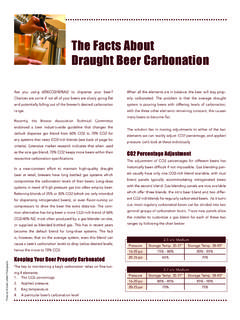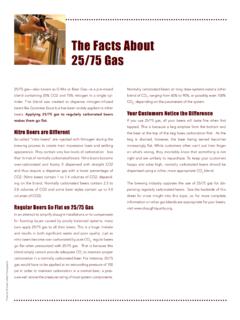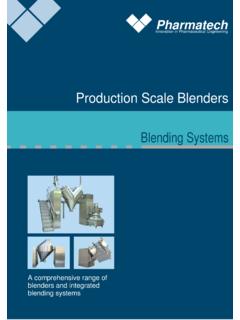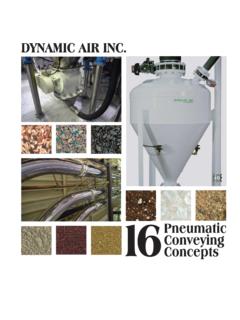Transcription of Brewers Association Draught Beer Quality for Retailers
1 Brewers Association Draught beer Quality for Retailers Brewers Association Draught beer Quality for Retailers 1. 2 Brewers Association Draught beer Quality for Retailers THE Brewers Association 'S Draught beer . Quality SUBCOMMITTEE'S OVERRIDING MISSION. IS TO IMPROVE THE Quality OF Draught beer . DISPENSED TO OUR CUSTOMERS. Retailers play a critical role in preserving the great flavor and aroma in beer created by Brewers . Great beer in a consumer's glass is no accident beer must be handled with care at retail. Draught beer systems commonly pour a wide range of Brewers '. and suppliers' beer , so everyone has an interest in keeping great beer great . Brewers and wholesalers, but also especially Retailers and consumers. This publication is intended to help Retailers consistently pour great beer and preserve profits through industry accepted best practices. When handled properly from brewery to bar to glass, Draught beer delivers what many consider to be the freshest, most flavorful beer available.
2 The job is only just beginning when the keg is tapped and beer begins to flow. Great beer Quality depends upon proper alignment of dispense conditions (temperature and pressure) and diligent housekeeping (regular beer line cleaning). We find Draught taps so often that we assume it must be relatively simple to maintain and serve beer this way. But behind the simple flick of a handle that sends beer streaming into our glass at the bar, you'll find systems that require precise design, explicit operating conditions, and rigorous, regular maintenance to ensure the proper dispense of high- Quality beer . Ken Grossman Sierra Nevada Brewing Company Brewers Association Technical Committee Co-Chair John Mallet Bell's Brewery Brewers Association Technical Committee Co-Chair Matt Meadows New Belgium Brewing Company Brewers Association Draught beer Quality Subcommittee Chair Brewers Association Draught beer Quality for Retailers 3.
3 TABLE OF CONTENTS. KEY CONSIDERATIONS AND COMPONENTS: WHAT SHOULD YOUR SYSTEM LOOK LIKE? .. 6. Gas .. 7. Carbon Dioxide (CO2) .. 7. CO2-Rich Blends & Gas Blenders .. 7. Nitrogen-Rich Blends, aka Guinness Gas" or Pre-Mix .. 8. beer Pumps .. 9. Air Compressors .. 10. Temperature .. 10. Recommended Serving Temperature .. 10. Keeping Draught Lines Cold .. 10. Direct Draw .. 11. Forced Air/Blower System .. 11. Glycol System .. 12. Equipment .. 12. FOBs/ beer Savers .. 13. System Distance .. 13. Draught beer Quality Components .. 14. Essential Draught Quality Components .. 14. Additional Draught Quality Factors .. 14. PROPER OPERATION OF YOUR Draught SYSTEM .. 15. Freshness .. 16. Time .. 16. Temperature .. 16. Kegs in Series .. 17. Glassware .. 18. Styles .. 18. Cleanliness .. 19. Testing for beer -Clean Glass .. 19. Storing Glassware .. 20. Pouring Draught beer .. 21. Technique .. 21. About Growlers .. 22. Protect Your Investment and Maximize Your Profits.
4 22. Draught beer SYSTEM CHECK LIST .. 23. Draught SYSTEM CLEANING AND MAINTENANCE .. 24. Draught Systems Cleaned and Serviced .. 25. Acid Cleaning .. 25. Electric Pump Cleaning: The Recommended Cleaning Procedure .. 26. CASE STUDIES AND ECONOMICS OF LINE CLEANING .. 27. Case Study I, II, III .. 28. Case Study IV .. 29. Worksheet .. 30. Economics of beer Line Cleaning .. 31. Brewers Association would like to thank the Draught beer Quality subcommittee for their continuing work for the advancement of Draught beer Quality ; Jeff Bell, Todd Blondis, Peter J. Coors, Rob Gerrity, Ken Grossman, Ernie Jimenez, Jaime Jurado, Charles Kyle, David Lujan, John Mallett, Matt Meadows (Chair), John Pinkerton, Kevin Reed, Jeff Schaefer, Ken Smith, Neil Witte. Photos Brewers Association , Automatic Bar Controls, Inc., Banner Equipment Company, McDantim, Inc., Micro Matic, Inc., Perlick Corporation, KegWorks Brewers Association , November 2014.
5 KEY CONSIDERATIONS AND. COMPONENTS: WHAT SHOULD. YOUR SYSTEM LOOK LIKE? 6 Brewers Association Draught beer Quality for Retailers GAS. Dispense gas in a Draught system performs three critical functions: 1. Maintaining the carbonation level of the beer from start to finish 2. Preserving the flavor of the beer in the keg 3. Pushing the beer from the keg to the faucet There are several different dispense gas options to choose from, depending on the system design. CARBON DIOXIDE (CO 2). Carbon dioxide (CO2 ) is the ideal dispense gas for direct-draw systems. To keep the beer properly carbonated in the keg, relatively low pressures are used. Proper pressure is a function of the carbonation level of the beer (expressed in volumes), the beer temperature and altitude. Vol. CO2 Temp. F psi psi psi psi psi psi psi psi psi psi psi 33 34 35 36 37 38 39 40 41 42 * Chart assumes sea-level altitudes. Add 1 psi for every 2,000 feet above sea level.
6 Based on Data from Methods of Analysis, American Society of Brewing Chemists, 5th Edition - 1949. If the proper pressure is exceeded, the beer will over-carbonate in the keg. With too little pressure, the beer will go flat in the keg. CO 2-RICH BLENDS & GAS BLENDERS. In longer systems the pressure required to deliver beer from the keg to the faucet may exceed the proper pressure of pure CO2. In this case, use a blend of CO2 and nitrogen (N2) gases. A lower percentage of CO2 allows for a higher applied pressure without over- carbonating the beer . For many long draw Draught systems, the proper blend is usually somewhere between 60% 80% CO2. This blend is achieved by using a gas blender, which produces the proper blend on site. Brewers Association Draught beer Quality for Retailers 7. Gas Blenders Gas blending systems are available for higher-volume applications that produce pure N2 onsite which is then blended with the CO2.
7 This eliminates the need to purchase cylinder N2. Nitrogen Generators For more information about which gas blend is correct for your Draught system, consult the Draught beer Quality Manual. NITROGEN-RICH BLENDS, AKA GUINNESS GAS" OR PRE-MIX . 25% CO2 /75% N2 is specifically blended for dispensing nitrogenized, or nitro . beers. These beers have very low CO2 content, yet require a high dispense pressure to push them through a specialized faucet. This gas is only intended for use with nitrogenized beers. It's widespread use in some markets for dispensing fully carbonated beers, does, in fact, make those beers go flat in the keg over the course of just a few days. 25%/75% is available premixed in a single cylinder, usually a nitrogen tank. It can also be produced with an onsite gas blender. The premixed cylinders have a much higher ongoing cost than gas blends produced onsite with a blender. 8 Brewers Association Draught beer Quality for Retailers Here is a comparison of using 25%/75% on your fully carbonated beers v.
8 Blending onsite with a more appropriate blend: GAS COST ANALYSIS FOR beer DISPENSED AT 25 PSI. Gas Type Price Cu. Ft Kegs Dispensed* Gas cost per keg Pre-Mix (25%/75%) $ 244 $ CO2 (50lb.) $ 405 $ N2 $ 244 $ Self Mix (70% CO2-30%N2) $ *A keg dispensed at 25 PSIG uses Cu. Ft. of Gas Calculations assume no waste Pre-Mix is more than twice as expensive as blending onsite. Dispensing carbonated beers with Pre-Mix wastes money and makes beer go flat. beer PUMPS. beer pumps are an alternative to using blended gases for systems with higher pressure requirements (such as longer runs or rises from cooler to tap). beer Pumps Pure CO2 is applied to the keg at ideal pressures. This pressure pushes the beer to the pump, which is mounted on the cooler wall above the keg. A higher gas pressure is applied to the pump, which in turn applies a direct pressure to the beer , pushing it the longer distance to the faucet. The gas drives the pump and does not come in direct contact with the beer , eliminating the risk of over-carbonation.
9 beer pumps are ideal for very long Draught systems (200 feet or more). Brewers Association Draught beer Quality for Retailers 9. AIR COMPRESSORS. Some systems employ compressed air instead of N2 for blending with CO2. While this declining practice allows higher pressures to be applied without risk of over- carbonation, oxygen ruins the flavor of the beer in less than a day, resulting in declining beer sales. Compressed air should never be used to dispense Draught beer . TEMPERATURE. Temperature directly affects the pressure required to keep CO2 in solution. As beer warms, dissolved CO2 comes out of solution, requiring increasingly higher applied pressures to maintain carbonation. Conversely, as beer gets colder, CO2 is more readily absorbed. The applied pressure must be adjusted downward to prevent over-carbonation. RECOMMENDED SERVING TEMPERATURE. Different styles of beer have different recommended serving temperatures.
10 It is in most cases impractical to maintain different serving temperatures for different beers in the same Draught system. Most Draught systems are designed around a generally accepted common serving temperature of 36 38 F. KEEPING Draught LINES COLD. Draught lines must be kept as cold as the keg. If the beer warms up in the Draught line, the CO2 will break out of solution and cause foaming at the tap. There are three types of cooling systems for Draught lines. 10 Brewers Association Draught beer Quality for Retailers DIRECT DRAW. In direct draw systems, the Draught lines are fully contained in the keg cooler. The most common examples are keg boxes with the tower mounted on top or walk-in coolers with the shank and faucet assemblies running through the wall. Direct Draw Kegerator FORCED AIR/BLOWER SYSTEM. Forced air blower systems are for lines which exit the cooler and are not longer than a distance of 25 feet. beer lines run to the tower through an insulated duct system.
















